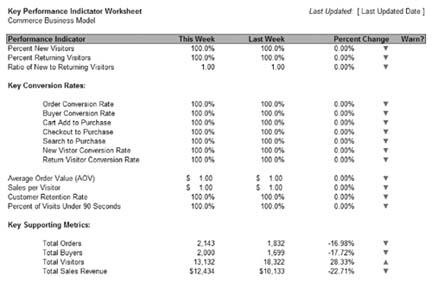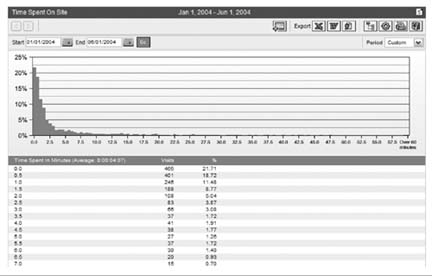Hack96.Key Performance Indicators for Online Retailers
Hack 96. Key Performance Indicators for Online Retailers
Online retailers, perhaps more than any other business model, should review key performance indicators on a regular basis to mine for changes in visitor interests and identify emerging sales opportunities. The key performance indicators that I recommend for online retailers are a relatively straightforward bunch; it's all about conversion and value. While you may be tempted to build out a complex report that provides every type of information possible, fight that temptation. Remember, most people aren't going to read a long, complex report full of numbers [Hack #91]. By focusing your efforts on the truly key indicators and providing a report similar to Figure 7-8, you will dramatically increase the readership and use of this report (and you cannot act upon something you don't even read, right?). One important thing to keep in mind when you're thinking about KPIs for online retail is seasonality. Sometimes a big decrease in key indicators means nothing more than the holidays are over and everyone is enjoying their toys. As with any web measurement report, always consider the following in as much context as is available, including time of year and other external factors. 7.7.1. Basic Key Performance Indicators for Online RetailersThe following key performance indicators should be considered core to the regular reporting for any online retailer. Each assumes a constant period of time, e.g., the previous day or the previous week, unless otherwise noted. Figure 7-8. KPI worksheet for online retailers 7.7.1.1 Sales per visitor.The ratio of sales per visitor is a simple proxy for your order conversion rate [Hack #37] that frames your ability to sell online in easy to understand terms. The greater the percentage of sales relative to the total number of visitors you attract, the better job you're doing. 7.7.1.2 Average order value (AOV).The average order value (AOV) is simply defined as the total revenue you took in divided by the total number of orders it took to get that revenue. Depending on the type of products you sell, your AOV may be either very stable month over month or fluctuate wildly from day to day or week to week. The former case is characteristic of higher priced, higher consideration items, the latter characteristic of sites that sell low-cost items or the overstock model of "buy what we have today since it will be gone tomorrow." As with any good KPI, your AOV is made interesting when it changes dramatically. Any time this happens, make sure you figure out why the change occurred and what effect that change will have on your online business. 7.7.1.3 Percent new and returning visitors.The percent of new and returning visitors are numbers calculated by your web measurement solution and describe how much of your audience you've originally acquired and how many people you've managed to get to return at least one time after their first visit. If, for some reason, your application doesn't provide the percentages, see [Hack #97] to learn how to make the necessary calculation. While it's hard to be too specific about what percentage of new and returning visitors is best for online retailers, there are a few general rules to keep in mind:
7.7.1.4 Ratio of new to returning visitors.This ratio, simply defined as the total number of new visitors divided by the total number of returning visitors, provides another view of your audience mix. The calculation yields a number between zero and n (with n being some positive integer that can, in theory, be very high if nobody ever returns to your site). This indicator quickly tells you whether you're acquiring, retaining, or basically neutral regarding your visitors. Smaller numbers indicate that you're retaining more visitors than you attract, something referred to as visitor retention mode. The smaller the number, the better the job you're doing at retaining visitors. Because online retailers depend so heavily on attracting new visitors, you rarely see this number below 1.0 on healthy retail sites. Larger numbers indicate that you're attracting more visitors than you retain, something referred to as visitor acquisition mode. Say, for example, the calculation yields a ratio of new to returning visitors of 5.0; this tells you that for every visitor you retain, you acquire five new visitors. In theory the number can be very large, but high numbers paint a picture of poor customer retention. Much like the 70:30 ideal split of new to returning visitors, the optimal ratio is between about 1.2 and 2.5, both indicating a constant influx of new visitors but not at the expense of returning visitors. 7.7.1.5 Customer retention rate.Your customer retention ratesometimes called percent returning customersis like your percent returning visitors, but it is specific to people who have made a previous purchase. It is, unfortunately, difficult to calculate without your web measurement application's assistance and likely the use of cookies [Hack #15], but it is worth including in your KPI report because it is so important to your online business. While the need to constantly attract new visitors to your retail web site is obvious, it is just as important to get people to return and purchase again. Your customer retention rate is usually a direct measure of how good a job you do after the purchase is made: do you ship on time, do the products arrive on time, are they the right products, and is your customer support helpful and friendly when needed? These questions speak to your ability to "delight your customers." Any time your customer retention rate spikes up, figure out why. Any time your customer retention rate dips, figure out why and fix the problem. 7.7.2. Advanced Key Performance Indicators for Online RetailersThe following metrics are more advanced but should be seriously considered, in addition to the basic indicators. The most important advanced KPIs are your bevy of conversion rates. 7.7.2.1 Order conversion rate.Your order conversion rate is the number of orders taken divided by the number of visits to the web site. While this is a fairly raw, top-line success metric, order conversion rate is important to watch for substantial changes that may indicate poor marketing acquisition efforts (for example, you just paid for a bunch of traffic that isn't converting at all). 7.7.2.2 Buyer conversion rate.Your buyer conversion rate is the number of purchasers divided by the total number of unique visitors to the site. Depending on what you sell, your order and buyer conversion rates may be very similar or relatively divergent. When these numbers are different, i.e., order conversion is higher, you know that you're getting short-term repeat visits that are purchasing; when buyer conversion is higher, or people are returning but not buying. 7.7.2.3 Cart add to purchase conversion rate.Cart add to purchase conversion rates are calculated by dividing the number of purchases by the number of cart starts (on a per-visit basis). You may need to hack your measurement application to get the number of cart starts by visit, but you don't want to calculate this number using page views, as it can be dramatically overstated if you do (assuming that every time a visitor looks at his shopping cart another page view is logged). The greater your ability to get visitors to start carts, the greater the likelihood they'll successfully complete those carts; however, sometimes you'll see an increase in cart starts but no change in total purchases. Often, this indicates that people are carting items to check the price or shipping charges, both indicators of poor usability. 7.7.2.4 Checkout-to-purchase conversion rate.The ratio of purchases to checkouts started (again, on a per-visit basis) is a gross indicator of ease of use in your checkout process. It is a reasonable assumption that once a visitor clicks the "Checkout" button, she actually intends to make the purchase. Since no business converts 100 percent of its carts, changes in this rate can help you understand which changes you're making in marketing acquisition or process design have a positive (or negative) impact on visitor success. 7.7.2.5 Search to purchase conversion rate.If you have some type of onsite or internal search [Hack #64], you should be monitoring your search to purchase conversion ratethe number of purchases driven by search divided by the total number of searches executed (measured on a page view basis). To make this calculation, you'll likely need to use either visitor segmentation tools [Hack #48] or an internal campaign [Hack #61] to track a visitor who searches through to a purchase. Still, because when search is done well it has such a positive impact on purchase behavior, you want to make this measurement. 7.7.2.6 New and returning visitor conversion rates.While you may want to measure conversion over a variety of visitor segments [Hack #48], the minimum segmentation you should monitor is new versus returning visitors. Differentiating these conversion rates will help you better understand how quickly you're likely to convert visitors as they engage with your site. If your new visitor conversion rate is very high, you might be selling low cost, low consideration items that visitors easily purchase. If your return visitor conversion rate is high, perhaps your visitors are browsing around the Internet comparison shopping, eventually settling on you when they're ready to make their purchase. 7.7.2.7 Percent of visits less than 90 seconds.The percent of visits under 90 seconds is a valuable indicator of the interest your visitors have in your products or services; in general, the higher the percentage, the worse the job you're doing. I use 90 seconds as a rough proxy for the minimum amount of time a visitor needs to do or learn anything meaningful on the average site; you may want to lower the threshold to 60 seconds, or increase it to 120 seconds, depending on how quickly people are able to navigate to actual products. To make the calculation, you'll need to find the "time spent per visit" or "time spent on site" reportthe report that tells you the number of visits broken down by time spent (Figure 7-9). Add up the number of visits less than 90 seconds and then divide by the total number of visits to the site. Using Figure 7-9 as an example, and assuming we had 5,000 total visits, the calculation would be:
Figure 7-9. Time spent on site report If your particular measurement application doesn't support the level of granularity afforded by WebSideStory's HBX, do your best. The essence of the KPI is an attempt to identify how many visits are too short to be meaningful. 7.7.3. Other Important MeasurementsFinally, in the online retail model, it is important to provide raw numbers as well as performance indicators in all reports. Reporting on your total orders, buyers, visitors, and sales revenue will likely placate those within your organization who absolutely need to see the raw numbers. By providing these numbers with otherwise well-formed KPIs, you'll increase the likelihood that your reports will be used. For a sample key performance indicator worksheet, built in Microsoft Excel from the measurements recommended in this hack, visit the author's web site at http://www.webanalyticsdemystified.com/kpi_worksheet. |
EAN: 2147483647
Pages: 157